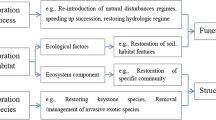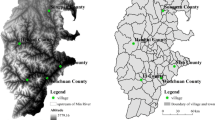Abstract
Ecological compensation is an important means to maintain the sustainability and stability of ecosystem services. The property rights analysis of ecosystem services is indispensable when we implement ecological compensation. In this paper, ecosystem services are evaluated via spatial transferring and property rights analysis. Take the Millennium Ecosystem Assessment (MA) as an example, we attempt to classify the spatial structure of 31 categories of ecosystem services into four dimensions, i.e., local, regional, national and global ones, and divide the property rights structure into three types, i.e., private property rights, common property rights and state-owned property rights. Through the case study of forestry, farming industry, drainage area, development of mineral resources, nature reserves, functional areas, agricultural land expropriation, and international cooperation on ecological compensation, the feasible ecological compensation mechanism is illustrated under the spatial structure and property rights structure of the concerned ecosystem services. For private property rights, the ecological compensation mode mainly depends on the market mechanism. If the initial common property rights are “hidden,” the implementation of ecological compensation mainly relies on the quota market transactions and the state investment under the state-owned property rights, and the fairness of property rights is thereby guaranteed through central administration.
Similar content being viewed by others
References
ACCA (Administrative Center for China’s Agenda 21) (2009). The Principle and Application of Ecological Compensation. Bei**g: Social Sciences Academic Press, 91–126 (in Chinese)
Albrecht M, Schmid B, Obrist M K, Schüpbach B, Kleijn D, Duelli P (2010). Effects of ecological compensation meadows on arthropod diversity in adjacent intensively managed grassland. Biol Conserv, 143(3): 642–649
Barzel Y (1989). Economic Analysis on Property Rights. Cambridge: Cambridge University Press
Costanza R, d’Arge R, de Groot R S, Farber S, Grasso M, Hannon B, Limburg K, Naeem S, O’Neill R V, Paruelo J, Raskin R G, Sutton P, van den Belt M (1997). The value of the world’s ecosystem services and natural capital. Nature, 387(6630): 253–260
Cuperus R, Canters K J, Udo de Haes H A (1999). Guidelines for ecological compensation associated with highways. Biol Conserv, 90(1): 41–51
de Groot R S, Wilson M, Boumans R (2002). A typology for the description, classification and valuation of ecosystem functions, goods and services. Ecol Econ, 41(3): 393–408
Herzog F, Dreier S, Hofer G, Marfurt C, Schupbach B, Spiess M, Walter T (2005). Effect of ecological compensation areas on floristic and breeding bird diversity in Swiss agricultural landscapes. Agric Ecosyst Environ, 108(3): 189–204
Junge X, Matthies P L, Hunziker M, Schüpbach B (2011). Aesthetic preferences of non-farmers and farmers for different land-use types and proportions of ecological compensation areas in the Swiss lowlands. Biol Conserv, 144(5): 1430–1440
Lu X X, Zhu Q L (2007). New Institutional Economics. Bei**g: Bei**g University Press, 191–193 (in Chinese)
MA (Millennium Ecosystem Assessment) (2003). Ecosystems and Human Well-being: A Framework for Assessment. Washington DC: Island Press
Ostrom E (1990). Governing the Commons: The Evolution of Institutions for Collective Action. Cambridge: Cambridge University Press
Rundcrantz K, Skärbäck E (2003). Environmental compensation in planning: A review of five different countries with major emphasis on the German system. Eur Environ, 13(4): 204–226
Villarroya A, Puig J (2010). Ecological compensation and environmental impact assessment in Spain. Environ Impact Assess Rev, 30(6): 357–362
Wang X J, Zhang Q Z, Liu X W, Wen W J (2010). The concept and standards of ecological compensation, and the role of government. China Population Resources and Environment, 20(5): 41–50 (in Chinese)
Author information
Authors and Affiliations
Corresponding author
Rights and permissions
About this article
Cite this article
Wen, W., Xu, G. & Wang, X. Spatial transferring of ecosystem services and property rights allocation of ecological compensation. Front. Earth Sci. 5, 280–287 (2011). https://doi.org/10.1007/s11707-011-0186-x
Received:
Accepted:
Published:
Issue Date:
DOI: https://doi.org/10.1007/s11707-011-0186-x




